Oil palm expansion is threatening Borneo’s rarest wild cats, reports a new study based on three years of fieldwork and more than 17,000 camera trap nights. Studying cats in five locations—each with different environments—in Sabah, Malaysian Borneo, researchers found that four of five cat species are threatened by habitat loss due to palm oil plantations.
“No other place has a higher percentage of threatened wild cats!” Jim Sanderson, an expert on the world’s small cats, told Mongabay.com. Pointing out that 80 percent of Borneo’s cats face extinction, Sanderson said that “not one of these wild cats poses a direct threat to humans.”
The groundbreaking study, undertaken by Jo Ross and Andrew Hearn with the UK’s Global Canopy Program’s Bornean Wild Cat and Clouded Leopard Project, has uncovered some of the first data on Borneo’s wild cats. The five cats species in Borneo include the Sunda clouded leopard, the bay cat, the marbled cat, the leopard cat, and the flat-headed cat (camera trap photos below).
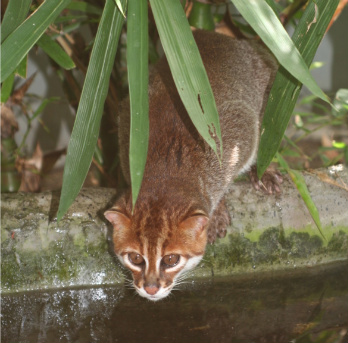 A flat-headed cat in captivity. Very little is known about this species, though it is heavily adapted to catching freshwater species and likely spends a lot of time hunting in water. Photo by: Jim Sanderson. |
“Sabah’s five species of wild cat are a special conservation treasure, and this study has made a tremendous contribution to knowledge about them,” Director of the WildCRU Professor David Macdonald said. Having worked with wild cats around the world, MacDonald is chairing a workshop in Sabah with various stakeholders to discuss conservation measures to protect the island’s embattled cats.
Ross and Hearn discovered that Borneo’s cats were present in both primary forests and recently logged over forest, yet only one of the five cat species—the leopard cat—utilizes palm oil plantations. For the other four species, palm oil plantations appear to be off-limits, even for migration purposes. In addition, Ross and Hearn found no evidence of the flat-headed cat utilizing or migrating in palm oil plantations, despite claims that the cats survive there. The researchers say that their findings should give special emphasis to keeping remaining forests—even those recently logged—free from further palm oil expansion.
The researchers also succeeded in estimating population densities for the Sunda clouded leopard using camera traps, as well as radio collaring and tracking an individual clouded leopard. The Sunda clouded leopard, which is endemic to Borneo and Sumatra, has only recently been declared a distinct species from the mainland clouded leopard.
Ross and Hearn have also taken the first photographs of the elusive bay cat in Sabah, and have recorded the world’s only video of the cat.
Three of Borneo’s five cats are classified as Endangered by the IUCN: the Sunda clouded leopard, the bay cat, and the flat-headed cat.
“Wild cat (and wildlife) endangerment is due to a wide variety of threats including: unmitigated massive habitat loss caused by palm oil plantations, unregulated destructive logging practices including widespread small-scale illegal logging, unchecked poaching even in conservation areas and wildlife reserves, destruction of fresh water rivers and streams from logging, dumping of debris from oil palm plantations, bottom dredging for gold, and pollution caused by the use of streams as sewers, and the widespread use of nets for fishing,” Sanderson explains.
Except for the leopard cat, Borneo’s cats all occur in low densities. The study found that to have a viable population of 250 Sunda clouded leopards requires an area of 3,000-8,600 square kilometers (1,158-3,088 square miles). There are very places in Sabah with this much forest left.
“These wild cats, and especially the Sunda clouded leopard are important emblems of Borneo’s forests, and it is vital to conserve them as umbrella species which provide protection to forest wildlife in general,” Macdonald said.
The marbled cat is classified as Vulnerable by the IUCN Red List. The leopard cat is the only one not considered threatened and is classified as Least Concern.
The workshop entitled “First Steps Towards Conserving Bornean Wild Cats” is hosted by the Sabah Wildlife Department in collaboration with Universiti Malaysia Sabah and Global Canopy Program’s Bornean Wild Cat and Clouded Leopard Project. The project is largely funded by the UK government’s Darwin Initiative.
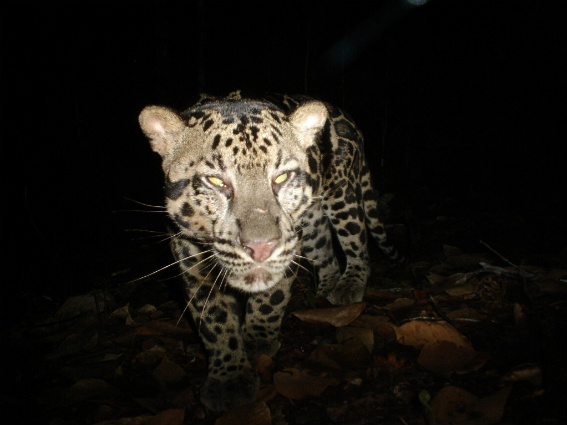
Sunda clouded leopard caught in a camera trap. In Borneo the Sunda clouded leopard is the largest cat species, but in Sumatra it competes with the Sumatran tiger. Copyright: Global Canopy Programme. Photo by: Jo Ross and Andrew Hearn.
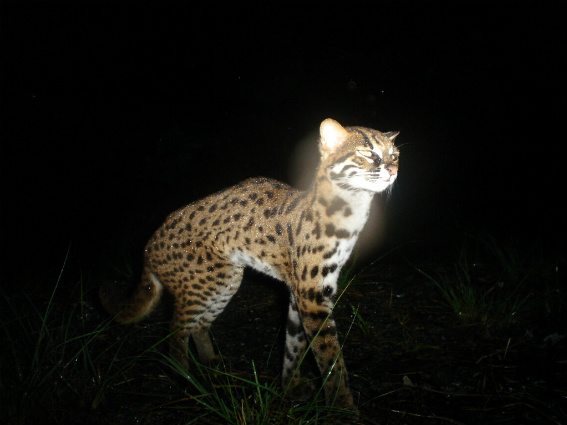
The leopard cat in Borneo is considered a unique subspecies. Copyright: Global Canopy Programme. Photo by: Jo Ross and Andrew Hearn.
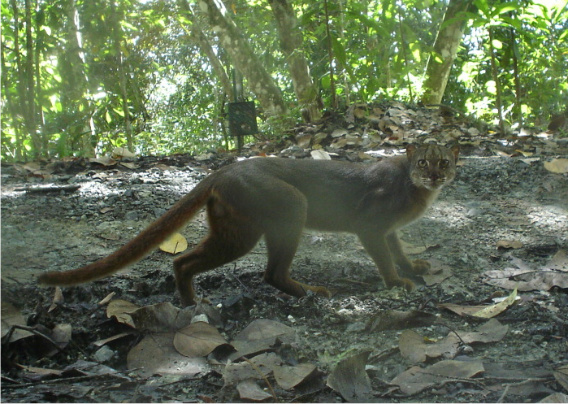
Researchers suspect there are less than 2,500 mature bay cats left in the wild. The species is endemic to Borneo and rampant deforestation is the main threat. Copyright: Global Canopy Programme. Photo by: Jo Ross and Andrew Hearn.

The marbled cat: this species has never been fully studied. Very little is known of its ecology. Copyright: Global Canopy Programme. Photo by: Jo Ross and Andrew Hearn.
Related articles
World’s first video of the elusive and endangered bay cat
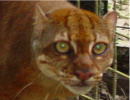
(11/05/2009) Rare, elusive, and endangered by habitat loss, the bay cat is one of the world’s least studied wild cats. Several specimens of the cat were collected in the 19th and 20th Century, but a living cat wasn’t even photographed until 1998. Now, researchers in Sabah, Malaysian Borneo, have managed to capture the first film of the bay cat (Catopuma badia). Lasting seven seconds, the video shows the distinctly reddish-brown cat in its habitat.
Saving the world’s most recently discovered cat species in Borneo
(04/10/2008) Last year two teams of scientists announced the discovery of a new species of clouded leopard in Borneo. The news came as conservationists launched a major initiative to conserve a large area of forest on an island where logging and oil palm plantations have consumed vast expanses of highly biodiverse tropical rainforest over the past thirty years. Now a pair of researchers are racing against the clock to better understand the behvaior of these rare cats to see how well they adapt to these changes in and around Danum Valley in Malaysia’s Sabah state. Andrew Hearn and Joanna Ross run the Bornean Wild Cat and Clouded Leopard Project, an effort that aims to understand and protect Borneo’s threatened wild cats, which include the flat-headed cat (Prionailurus planiceps), marbled cat (Pardofelis marmorata) leopard cat (Prionailurus bengalensis) the endemic bay cat (Catopuma badia) and the Bornean clouded leopard (Neofelis nebulosa).
Often overlooked, small wild cats are important and in trouble

(08/05/2008) While often over-shadowed by their larger and better-known relatives like lions, tigers, leopards, and jaguars, small cats are important indicators of the health of an ecosystem, says a leading small cat expert who uses camera traps extensively to document and monitor mammals in the wild. Dr Jim Sanderson, a scientist with the Small Cat Conservation Alliance and Conservation International, is working to save some of the world’s rarest cats, including the Andean cat and Guigna of South America and the bay, flat-headed, and marbled cats of Southeast Asia. In the process Sanderson has captured on film some of the planet’s least seen animals, including some species that have never before been photographed. He has also found that despite widespread criticism, some corporate entities are effectively protecting remote wilderness areas.